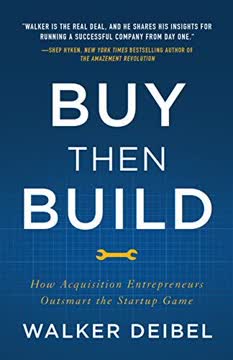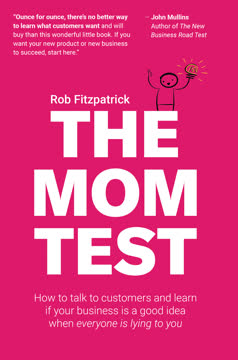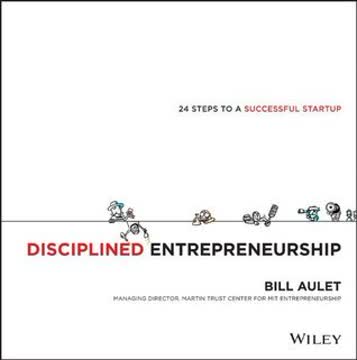Key Takeaways
1. Define your target customer with laser-like focus
Focus is very important because entrepreneurs have very limited time and resources and so must be hyper-efficient.
Narrow your market. Start by identifying a specific beachhead market where you can dominate quickly. Create an End User Profile that details demographics, motivations, and behaviors of your target customer. Then, develop a detailed Persona – a real individual who embodies your ideal customer. This laser focus allows you to tailor your product and marketing efforts precisely.
Validate your focus. Identify your "Next 10 Customers" who match your Persona to ensure you're not building a one-customer solution. Map out the Decision-Making Unit (DMU) to understand all the players involved in the purchasing process. This level of specificity helps you:
- Develop a product that truly meets customer needs
- Create targeted marketing messages
- Streamline your sales process
- Allocate resources efficiently
2. Quantify the value proposition for your beachhead market
Set your pricing based on the value the customer gets from your product, rather than on your costs.
Calculate tangible benefits. Develop a Quantified Value Proposition that clearly demonstrates how your product solves your customer's top priority problem. This should be expressed in concrete terms – money saved, time reduced, or other measurable improvements. Create a simple comparison between the customer's current "as-is" state and the "possible" state with your product.
Align with priorities. Ensure your value proposition addresses the Persona's top priorities:
- Identify the customer's most pressing pain points
- Quantify the improvement your product offers
- Express the value in the customer's own language and metrics
- Be conservative in your estimates to maintain credibility
3. Design a business model that captures value effectively
How you will capture your share of the value you create is a topic that deserves more attention than entrepreneurs usually give it.
Choose strategically. Your business model determines how you extract value from customers. Consider various options:
- One-time charges vs. recurring revenue
- Subscription models
- Freemium strategies
- Transaction fees
- Usage-based pricing
Optimize for growth. Select a model that:
- Aligns with your customer's purchasing preferences
- Maximizes long-term value capture
- Allows for scalability
- Provides predictable revenue streams
- Creates barriers to entry for competitors
Remember that changing your business model later is often difficult, so choose carefully from the start.
4. Calculate and optimize customer lifetime value (LTV)
The Lifetime Value of an Acquired Customer calculation is the profit that a new customer will provide on average, discounted to reflect the high cost of acquiring capital that a startup faces.
Understand the components. LTV calculation includes:
- One-time and recurring revenue streams
- Gross margins for each revenue stream
- Customer retention rates
- Product lifespan and repurchase rates
- Cost of capital for your business
Maximize LTV. Strategies to increase lifetime value:
- Develop high-margin add-on products or services
- Improve customer retention through excellent service
- Create upselling opportunities
- Increase pricing as you establish market dominance
- Reduce your cost of capital through efficient operations
Aim for an LTV that is at least 3 times your Cost of Customer Acquisition (COCA) to ensure a sustainable business model.
5. Minimize customer acquisition costs (COCA) through strategic sales processes
Understanding the details of customer acquisition will make clear to you the drivers of costs so that you will know over time how to make the sales process shorter and more cost-effective.
Map your sales process. Develop short-term, medium-term, and long-term sales strategies:
- Short-term: Focus on direct sales and education to create initial demand
- Medium-term: Incorporate distributors and more efficient channels
- Long-term: Leverage word-of-mouth and automated processes
Reduce COCA over time. Strategies include:
- Automating parts of the sales process
- Improving lead quality and conversion rates
- Shortening the sales cycle
- Leveraging word-of-mouth referrals
- Choosing a business model that facilitates easier sales
Continuously measure and optimize your COCA to improve profitability and scalability.
6. Test key assumptions before building your minimum viable business product
Identifying key assumptions is the first part of the process to validate your primary market research by looking for customers to take specific actions, which will happen in the next step.
Break down assumptions. Identify and prioritize the critical assumptions underlying your business plan:
- Customer needs and preferences
- Market size and growth
- Technical feasibility
- Cost structure
- Competitive landscape
Design targeted experiments. Create low-cost, quick tests to validate or refute each key assumption:
- Surveys and interviews
- Landing page tests
- Prototype demonstrations
- Small-scale pilot projects
Use the results to refine your business model and product offering before investing significant resources in development.
7. Validate market demand with real customer traction
Now that we have launched our product, show measurable proof that the customers are adopting the product; no rose-colored glasses—data is required.
Measure engagement. Track key metrics that demonstrate real customer interest and adoption:
- User sign-ups and activations
- Daily/weekly active users
- Retention rates
- Customer feedback and satisfaction scores
- Virality coefficient (how often users refer others)
Analyze purchasing behavior. Look for concrete evidence that customers value your product enough to pay for it:
- Conversion rates from free to paid users
- Average revenue per user
- Churn rates
- Upsell and cross-sell success
Use this data to iterate on your product, refine your marketing strategy, and prove to investors that you've found product-market fit. Remember, early traction is the strongest indicator of future success.
Last updated:
FAQ
What's Disciplined Entrepreneurship: 24 Steps to a Successful Startup about?
- Structured Approach: The book by Bill Aulet provides a systematic 24-step process for launching a successful startup, emphasizing that entrepreneurship is a skill that can be learned.
- Customer-Centric Focus: It stresses the importance of understanding customer needs and aligning product development with those needs to ensure a strong product-market fit.
- Comprehensive Framework: The book integrates various aspects of entrepreneurship, from market segmentation to product specification, offering a valuable resource for both new and experienced entrepreneurs.
Why should I read Disciplined Entrepreneurship?
- Practical Guidance: The book offers step-by-step guidance that can significantly increase the likelihood of startup success, based on Aulet's experience teaching at MIT.
- Real-World Examples: It includes numerous case studies that illustrate the application of the 24 steps, making the concepts relatable and easier to understand.
- Comprehensive Toolbox: Combining classic entrepreneurship theory with modern practices, it serves as a must-read for anyone serious about starting a business.
What are the key takeaways of Disciplined Entrepreneurship?
- 24 Steps to Success: The book outlines 24 essential steps that guide entrepreneurs from idea conception to market launch, each building on the previous one.
- Market Research Importance: Emphasizes the need for thorough market research to understand customer pain points and validate business ideas.
- Iterative Process: Entrepreneurs should be prepared to revisit and refine earlier steps based on new insights, adapting to market needs.
How does Disciplined Entrepreneurship define the Total Addressable Market (TAM)?
- Definition of TAM: It is the total revenue opportunity available if a product achieves 100% market share, helping gauge market potential.
- Market Validation: Calculating TAM allows entrepreneurs to validate their market opportunity and ensure it is large enough for a sustainable business.
- Strategic Planning: Understanding TAM aids in strategic planning, resource allocation, and attracting investors by providing a clear market landscape.
What is the beachhead market in Disciplined Entrepreneurship?
- Initial Target Market: The beachhead market is the first market segment a startup targets to establish a foothold and gain traction.
- Specific Needs Focus: It involves identifying a specific customer persona and tailoring the product to meet their unique needs and preferences.
- Foundation for Growth: Successfully capturing the beachhead market allows for expansion into adjacent markets, leveraging insights and relationships built.
How does Disciplined Entrepreneurship suggest testing key assumptions?
- Empirical Testing: The book emphasizes designing experiments to validate or refute key assumptions about the business model and customer behavior.
- Customer Engagement: Engaging potential customers through surveys, pre-orders, or pilot programs provides valuable insights into their preferences.
- Iterative Feedback: Continuous testing and iteration based on customer feedback help refine the product to ensure it meets market needs.
How do I identify my Core as an entrepreneur according to Disciplined Entrepreneurship?
- Unique Value Proposition: Your Core differentiates your business from competitors, allowing you to deliver unique value to customers.
- Focus on Strengths: Identify what your team does exceptionally well that others cannot easily replicate, leveraging unique skills or intellectual property.
- Long-Term Protection: The Core should provide a sustainable competitive advantage, essential for protecting your business from competitors.
What is the Minimum Viable Business Product (MVBP) in Disciplined Entrepreneurship?
- Core Product Offering: The MVBP is the simplest version of a product that delivers value to customers and can be sold to test market assumptions.
- Three Essential Conditions: It must provide value, customers must be willing to pay for it, and it should facilitate a feedback loop for further development.
- Iterative Testing: The MVBP allows entrepreneurs to gather real-world data on customer preferences, informing future product iterations.
How does Disciplined Entrepreneurship define the Persona?
- Definition of Persona: A detailed representation of your ideal customer, based on real data and insights, helping to humanize the target market.
- Specificity Importance: Creating a Persona involves specifying demographics, motivations, and purchasing criteria, ensuring a clear understanding of the target audience.
- Guides Product Development: The Persona serves as a reference point for decision-making, ensuring the product aligns with customer expectations.
What is the importance of the Cost of Customer Acquisition (COCA) in Disciplined Entrepreneurship?
- Understanding Expenses: COCA measures the total cost associated with acquiring a new customer, including marketing and sales expenses.
- Sustainability Metric: A sustainable business model requires that COCA be significantly lower than the Lifetime Value (LTV) of an acquired customer.
- Guiding Strategy: Analyzing COCA helps identify areas for improvement in sales and marketing strategies to reduce costs over time.
How does Disciplined Entrepreneurship recommend developing a product plan?
- Feature Prioritization: The product plan should identify which features to build based on customer feedback, focusing on those that deliver the most value.
- Market Expansion Strategy: It should outline plans for entering adjacent markets after establishing a strong position in the beachhead market.
- Iterative Improvement: The plan should be flexible, allowing for adjustments based on ongoing customer feedback and market dynamics.
What role does the Decision-Making Unit (DMU) play in customer acquisition according to Disciplined Entrepreneurship?
- Identifying Stakeholders: The DMU consists of all individuals involved in the purchasing decision, including champions, end users, and economic buyers.
- Influencing Sales Strategy: Understanding the DMU helps tailor the sales approach to address the needs and concerns of each stakeholder.
- Navigating Objections: Recognizing who holds veto power and who influences decisions helps navigate the complexities of the sales process.
Review Summary
Disciplined Entrepreneurship is highly praised for its practical, step-by-step approach to starting a successful business. Readers appreciate its clear methodology, real-world examples, and focus on customer-centric development. The book is particularly valuable for tech startups and innovation-driven ventures. While some find it dry or overly structured, many consider it an essential guide for both new and experienced entrepreneurs. Critics note its focus on high-growth startups may limit applicability for small or traditional businesses. Overall, the book is widely recommended for its comprehensive and actionable advice.
Similar Books










Download PDF
Download EPUB
.epub digital book format is ideal for reading ebooks on phones, tablets, and e-readers.




